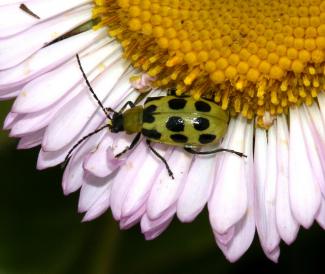
Image Credit: S. Rae
Root-feeding beetles (long-horned beetles Cerambycidae; leaf-beetles Chrysomelidae; scarab chafer-beetles Scarabaeidae; click beetles Elateridae) – herbivores (roots). The long-horned beetles are represented by several species of the Lepturinae (probably Judolia); the leaf-beetles by most of the Alticinae and some Chrysomelinae (i.e., Chrysolina) and probably only a small number of Serica, Dichelonyx, Diabrotica; Buprestidae and numerous click beetles.






Root-feeding is a habit shared by many leaf-beetles in several subfamilies. Root-feeding is most characteristic of the Alticinae, the hop-flea beetles (see hind legs on upper center photo); many of these are pests of agricultural crops in the PNW.
On the upper left are a mating pair of Klamath-weed beetles, the major successful biocontrol agent for Klamath weed (Hypericum perforatum) in Oregon.
On the upper right is the pest species Diabrotica undecimpunctata found in many ecosystems and the flowers of a great many plant species. On the lower left are 2 chafer beetles, Serica and Dichelonyx, both flower-visiting taxa, that feed respectively on diverse herbs and conifer roots.
On the lower right is a representative click beetle, with many root-feeding species in the PNW. Leaf-beetles can be recognized by their bright color patterns and their broad 3-segmented tarsal segments.
Chafers are distinguished by their clubbed antennae and digging legs (see picture). Click beetles are easily recognized by the shape of the thorax (pointed basolaterally).